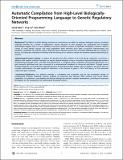Automatic Compilation from High-Level Biologically-Oriented Programming Language to Genetic Regulatory Networks
Author(s)
Beal, Jacob S.; Lu, Ting; Weiss, Ron
DownloadBeal-2011-Automatic Compilatio.pdf (1.239Mb)
PUBLISHER_CC
Publisher with Creative Commons License
Creative Commons Attribution
Terms of use
Metadata
Show full item recordAbstract
Background
The field of synthetic biology promises to revolutionize our ability to engineer biological systems, providing important benefits for a variety of applications. Recent advances in DNA synthesis and automated DNA assembly technologies suggest that it is now possible to construct synthetic systems of significant complexity. However, while a variety of novel genetic devices and small engineered gene networks have been successfully demonstrated, the regulatory complexity of synthetic systems that have been reported recently has somewhat plateaued due to a variety of factors, including the complexity of biology itself and the lag in our ability to design and optimize sophisticated biological circuitry.
Methodology/Principal Findings
To address the gap between DNA synthesis and circuit design capabilities, we present a platform that enables synthetic biologists to express desired behavior using a convenient high-level biologically-oriented programming language, Proto. The high level specification is compiled, using a regulatory motif based mechanism, to a gene network, optimized, and then converted to a computational simulation for numerical verification. Through several example programs we illustrate the automated process of biological system design with our platform, and show that our compiler optimizations can yield significant reductions in the number of genes () and latency of the optimized engineered gene networks.
Conclusions/Significance
Our platform provides a convenient and accessible tool for the automated design of sophisticated synthetic biological systems, bridging an important gap between DNA synthesis and circuit design capabilities. Our platform is user-friendly and features biologically relevant compiler optimizations, providing an important foundation for the development of sophisticated biological systems.
Date issued
2011-08Department
Massachusetts Institute of Technology. Department of Electrical Engineering and Computer ScienceJournal
PLoS ONE
Publisher
Public Library of Science
Citation
Beal, Jacob, Ting Lu, and Ron Weiss. “Automatic Compilation from High-Level Biologically-Oriented Programming Language to Genetic Regulatory Networks.” Ed. Eshel Ben-Jacob. PLoS ONE 6 (2011): e22490.
Version: Final published version
ISSN
1932-6203